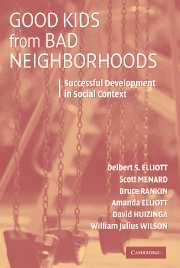Book contents
- Frontmatter
- Contents
- List of Tables and Figures
- Foreword by Richard Jessor
- Acknowledgments
- 1 Growing Up in Disadvantaged Neighborhoods
- 2 Growing Up in Denver and Chicago: The MacArthur Neighborhood Study
- 3 Good and Bad Neighborhoods for Raising Children
- 4 The Effects of Growing Up in a Bad Neighborhood: Initial Findings
- 5 Critical Dimensions of Neighborhood Organization and Culture
- 6 The Effects of Neighborhood Organization and Culture
- 7 Family Influences: Managing Disadvantage and Promoting Success
- 8 School Climate and Types of Peer Groups
- 9 What Matters Most for Successful Youth Development?
- 10 Successful Development in Disadvantaged Neighborhoods
- Appendix A
- Appendix B
- References
- Author Index
- Subject Index
7 - Family Influences: Managing Disadvantage and Promoting Success
Published online by Cambridge University Press: 06 August 2009
- Frontmatter
- Contents
- List of Tables and Figures
- Foreword by Richard Jessor
- Acknowledgments
- 1 Growing Up in Disadvantaged Neighborhoods
- 2 Growing Up in Denver and Chicago: The MacArthur Neighborhood Study
- 3 Good and Bad Neighborhoods for Raising Children
- 4 The Effects of Growing Up in a Bad Neighborhood: Initial Findings
- 5 Critical Dimensions of Neighborhood Organization and Culture
- 6 The Effects of Neighborhood Organization and Culture
- 7 Family Influences: Managing Disadvantage and Promoting Success
- 8 School Climate and Types of Peer Groups
- 9 What Matters Most for Successful Youth Development?
- 10 Successful Development in Disadvantaged Neighborhoods
- Appendix A
- Appendix B
- References
- Author Index
- Subject Index
Summary
SYNOPSIS
The family is added to our model of contextual effects and we estimate the power of this new, multilevel contextual model to account for neighborhood-level and individual-level rates of successful youth development. Parents are assumed to play the dominant role in socialization and development, particularly in early childhood. Some are very skilled and effective in directing the developmental progress of their children; others are not. Our concern in this chapter is to understand how the neighborhood influences the form and quality of parenting, how it shapes parenting practices and supplements or limits the type and quality of resources available to the family, and how it structures the experiences and events in the lives of both parents and children. Moreover, we test the widely held idea that a strong, effective family can buffer youth from the effects of neighborhood Disadvantage, physical deterioration and disorganization; and its corollary, that the combination of a bad neighborhood and a dysfunctional, ineffective family have particularly disastrous effects on youth development.
We focus on four characteristics of families: (1) family social and economic resources, (2) family dysfunction, (3) parenting practices, and (4) the normative and value climate in the family. Families living in Disadvantaged and/or Deteriorated Neighborhoods had fewer resources (Income and Support Networks) and poorer Parenting Practices than families living in more Advantaged and Well-Kept Neighborhoods, and these two features of the family context were the strongest predictors of successful youth development outcomes at the neighborhood level.
- Type
- Chapter
- Information
- Good Kids from Bad NeighborhoodsSuccessful Development in Social Context, pp. 161 - 202Publisher: Cambridge University PressPrint publication year: 2006



